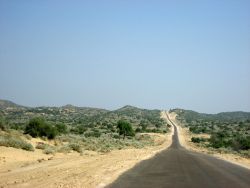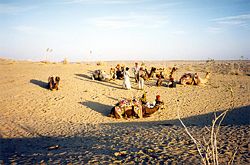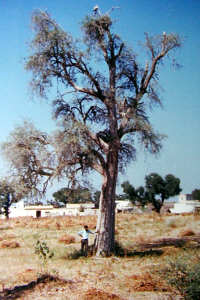Difference between revisions of "Thar Desert" - New World Encyclopedia
(→Sources and Further Reading: formated) |
Mary Anglin (talk | contribs) m |
||
| Line 1: | Line 1: | ||
{{Claimed}} {{Images OK}} | {{Claimed}} {{Images OK}} | ||
| − | + | ||
[[Image:Thar_Desert_satellite.jpg|thumb|A [[NASA]] satellite image of the '''Thar Desert''', with the India-Pakistan border superimposed . The desert is at the center left of the image; the [[Indus River]] and its tributaries are to the left side of the desert, and the dark green line at the bottom center of the image is the [[Aravalli Range]].]] | [[Image:Thar_Desert_satellite.jpg|thumb|A [[NASA]] satellite image of the '''Thar Desert''', with the India-Pakistan border superimposed . The desert is at the center left of the image; the [[Indus River]] and its tributaries are to the left side of the desert, and the dark green line at the bottom center of the image is the [[Aravalli Range]].]] | ||
Revision as of 05:07, 18 June 2007
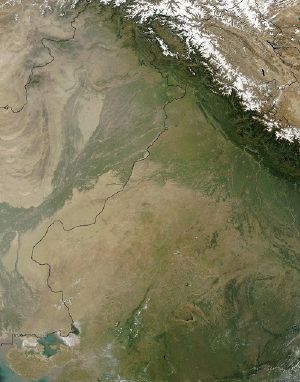
The Thar Desert (Hindi: थार रेगिस्तान) , also known as the Great Indian Desert, is a desert located in western India and southeastern Pakistan. It lies mostly in the Indian state of Rajasthan, and extends into the southern portion of Haryana and Punjab states and into northern Gujarat state. In Pakistan, the desert covers eastern Sind province and the southeastern portion of Pakistan's Punjab province. In Pakistan's Punjab province it is known as the Cholistan Desert. Tharparker District of province Sindh Pakistan is also a part of Thar desert. Thar Desert's Total area is about 200,000 sq km. The Thar Desert is bounded on the northwest by the Sutlej River, on the east by the Aravalli Range, on the south by the salt marsh known as the Rann of Kutch (parts of which are sometimes included in the Thar), and on the west by the Indus River. Its boundary to the large thorny steppe to the north is ill-defined. Depending on what areas are included or excluded, the nominal size of the Thar can vary significantly.
According to the WWF definition, the desert proper has 92,200 square miles (238,700 km²). Another source gives the area of the Thar Desert as 446,000 km² extending 805 km (about 500 mi) long and about 485 km (about 300 mi) wide, with 208,110 square kilometres in India. Of the Indian portion, 61% falls in Rajasthan, 20% in Gujarat and 9% in Punjab and Haryana combined. The greater portion lies in Rajasthan, covering about three-fifths of the total geographical area.[1]
Origin of the Thar Desert
The origin of the Thar Desert is a controversial subject. Some consider it to be 4000 to 10,000 years old, whereas others state that aridity started in this region much earlier. Another theory states that area turned to desert relatively recently: perhaps around 2000 - 1500 B.C.E. Around this time the Ghaggar ceased to be a major river. It now terminates in the desert. It has been observed through remote sensing techniques that Late Quaternary climatic changes and neotectonics have played a significant role in modifying the drainage courses in this part and a large number of palaeochannels exist.
Most of the studies share the opinion that the palaeochannels of the Sarasvati coincide with the bed of present day Ghaggar and believe that the Sutlej along with the Yamuna once flowed into the present Ghaggar riverbed. It has been postulated that the Sutlej was the main tributary of the Ghaggar and that subsequently the tectonic movements might have forced the Sutlej westwards, the Yamuna eastwards and thus dried up the Ghaggar.
Physiography and geology
There are three principal landforms in the desert region i.e.
- The predominantly sand covered Thar
- Plains with hills including the central dune free country
- Hills
It is a desolate country where sand is piled up into huge wind blown dunes (technically this is known as an erg). The sand dunes are of three types viz., longitudinal parabolic, transverse and barchans. The first type, running NNE-SSW, i.e. parallel to the prevailing winds, occurs to the south and west of the Thar. The transverse dunes, aligned across the wind direction, to the east and south of Thar and barchans, with the conclave sides facing the wind in the interior, predominant in Central Thar. On the whole the Thar Desert slopes imperceptibly towards the Indus Plain and surface unevenness is mainly due to sand dunes. The dunes in the south are higher, rising sometimes to 152 m whereas in the north they are lower and rise to 16 m above the ground level.
The Aravalli Range forms the main landmark to the south-east of Thar Desert. The more humid conditions that prevail near the Aravallis prevent the extension of Thar Desert towards the east and the Ganges Valley. In the heart of the sand covered area, the bare, dune free country of Barmer, Jaisalmer and Bikaner present an anomaly.[2]
Desert soils
The soils of the Arid Zone are generally sandy to sandy-loam in texture. The consistency and depth vary according to the topographical features. The low-lying loams are heavier and may have a hard pan of clay, calcium carbonate (CaCO3) or gypsum. The pH varies between 7 and 9.5. The soils improve in fertility from west and northwest to east and northeast. Desert soils are Regosols of wind blown sand and sandy fluiratile deposits, derived from the disintegration of rock in the subjacent areas and blown in from the coastal region and the Indus Valley. The desert soils occupy the districts of Jodhpur, Bikaner, Churu, Ganganagar, Barmer, Jaisalmer, and Jalore. The Thar consists mainly of the wind-blown sand. The area is covered not only by sheet of sand but also of rocky projections of low elevations which constitute the older rocks of the country. Water is scarce and occurs at great depths, from 30 to 120 m below the ground level.[3]
Some of these soils contain a high percentage of soluble salts in the lower horizons, turning water in the wells poisonous. Being poor in organic matter they show a low loss on ignition. They contain varying amount of calcium carbonate.
Biodiversity
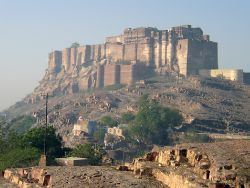
Stretches of sand in the desert are interspersed by hillocks and sandy and gravel plains. Due to the diversified habitat, the vegetation and animal life in this arid region is very rich. About 23 species of lizard and 25 species of snakes are found here and several of them are endemic to the region.
Some wildlife species, which are fast vanishing in other parts of India, are found in the desert in large numbers such as the Great Indian Bustard (Ardeotis nigriceps), the Blackbuck (Antilope cervicapra), the Indian Gazelle (Gazella bennettii) and the Indian Wild Ass (Equus hemionus khur) in the Rann of Kutch. How these animals and insects survive in these harsh conditions, under such high temperature and without drinking water and green vegetation are amazing. They have evolved excellent survival strategies, their size is smaller than other similar animals living in different conditions, and they are mainly nocturnal. There are certain other factors responsible for the survival of these animals in the desert. Due to the lack of water in this region, transformation of the grasslands into cropland has been very slow. The protection provided to them by a local community, the Bishnois, is also a factor.
The Desert National Park, Jaisalmer, spread over an area of 3162 km², is an excellent example of the ecosystem of the Thar Desert, and its diverse fauna. Great Indian Bustard, Blackbuck, chinkara, desert fox, Bengal fox, wolf, desert cat etc. can be easily seen here. Seashells and massive fossilized tree trunks in this park record the geological history of the desert. The region is a haven for migratory and resident birds of the desert. One can see many eagles, harriers, falcons, buzzards, kestrel and vultures. Short-toed Eagles (Circaetus gallicus), Tawny Eagles (Aquila rapax), Spotted Eagles (Aquila clanga), Laggar Falcons (Falco jugger) and kestrels are the commonest of these.
Tal Chhapar Sanctuary is a very small sanctuary in Churu District, 210 km from Jaipur, in the Shekhawati region. This sanctuary is home to a large population of graceful Blackbuck. Desert Fox and desert cat can also be spotted along with typical avifauna such as partridge and sand grouse.
Natural vegetation
The natural vegetation is classed as Northern Desert Thorn Forest (Champion 1936). These occur in small clumps scattered in a more or less open forms. Density and size of patches increase from West to East following the increase in rainfall. Natural vegetation of Thar Desert is composed of following tree, shrub and herb species.[4]
Tree species
Acacia jacquemontii, Acacia leucophloea, Acacia senegal, Anogeissus rotundifolia, Prosopis cineraria, Salvadora oleoides , Tecomella undulata, Tamarix articulata
Small trees and shrubs
Calligonum polygonoides, Acacia jacquemontii, Balanites roxburghii, Ziziphus jujuba, Ziziphus nummularia, Calotropis procera, Suaeda fruticosa, Crotalaria burhia, Aerva tomentosa, Clerodendrum multiflrum, Leptadenia pyrotechnica, Lycium barbarum, Grewia populifolia, Commiphora mukul, Euphorbia nerifolia, Cordia rothii, Maytenus emorginata Capparis decidua
Herbs
Eleusine compressa, Dactyloctenium scindicum, Cenchrus biflorus, Cenchrus setigerus, Lasiurus hirsutus, Cynodon dactylon, Panicum turgidum, Panicum antidotale, Dichanthium annulatum, Sporobolus marginatus, Saccharum spontaneum, Cenchrus ciliaris, Desmostachya bipinnata, Cyperus arenarius, Erogrostis species, Ergamopagan species, Phragmitis species, Typha species
Greening desert and checking shifting sand dunes
The soil of the Thar Desert remains dry for a longer period in the year and is therefore most prone to wind erosion. Due to the high velocity of winds in these areas the dust is blown off with it and deposited on fertile lands causing a problem of shifting sand dunes. The movement of the shifting sand buries fences and blocks roads and railway tracks. Permanent solution to this problem of shifting sand dunes can be provided by fixation of the shifting sand dunes with suitable plant species and planting windbreaks and shelterbelts. They also provide protection from hot or cold and desiccating winds and the invasion of sand.
The local tree species for planting in the desert region are not many and they are also very slow growing. The introduction of exotic tree species in the desert for plantation has become necessary. Many species of Eucalyptus, Acacia, Cassia and other genera have been tried from Israel, Australia, USA, Russia, Southern Rhodesia, Chile, Peru, Sudan etc. in Thar Desert Acacia tortilis has proved to be the most promising species for desert afforestation and has helped in checking the spread of desert soils to other areas and fixing of sand dunes. The jojoba is one other promising species of economic value found suitable for planting in these areas.
The Rajasthan Canal system is the major irrigation scheme of the Thar Desert and is conceived to reclaim it and also to check spreading of the desert to fertile areas.The river Luni is the only natural water source that drains inside a lake in the desert.
Desert economy
{{#invoke:Message box|ambox}}
Agriculture
The main occupation of people in desert is agriculture and animal husbandry. Agriculture is not a dependable proposition in this area— after the rainy season, at least 33% of crops definitely fail. Animal husbandry, trees and grasses, intercropped with vegetables or fruit trees, is the most viable model for arid, drought-prone regions. Arid regions of Western Rajasthan, Gujarat, and Southern parts of Haryana receive low precipitation (under 40 CMS. normally) with high evapotranspiration due to high solar radiation and wind speed. The region faces frequent droughts. Overgrazing due to the high animal population, wind and water erosion, mining and other industries are serious land degradation processes.[5]
Livestock
In the last 15-20 years, the Rajasthan desert has seen many changes, including a manifold increase of both the human and animal population. Animal husbandry has become popular due to the difficult farming conditions. At present, there are ten times more animals per person in Rajasthan than the national average, and overgrazing is also a factor affecting climatic and drought conditions.
Agro-forestry
Forestry has an important part to play in the amelioration of the conditions in semi-arid and arid lands. If properly planned forestry can make an important contribution to the general welfare of the people living in desert areas. The living standard of the people in the desert is low. They can not afford other fuels like gas, kerosene etc. Fire wood is their main fuel, of the total consumption of wood about 75 percent is firewood. The forest cover in desert is low. The forest is insufficient to fulfill the need of firewood. This diverts the much needed cattledung from the field to the hearth. This in turn results into the decrease in agricultural production.
The scientists of Central Arid Zone Research Institute,Jodhpur (CAZRI), have successfully developed and improved dozens of traditional and non-traditional crops/fruits, such as Ber trees (like plums) that produce much larger fruits than before (lemon-size) and can thrive with minimal rainfall. These trees have become a profitable option for farmers. One example from a case study of horticulture showed that in situation of budding in 35 plants of Ber and Guar (Gola, Seb & Mundia variety developed in CAZRI), using only one hectare of land, yielded 10,000 kg. of Ber and 250 kg. of Guar, which translates into double or even triple profit.[6]
The most important tree species, in Agro-forestry , providing livelihood support in Thar desert is Prosopis cineraria.
Prosopis cineraria provides wood of construction class. It is used for house-building, chiefly as rafters, posts scantlings, doors and windows, and for well construction water pipes, upright posts of Persian wheels, agricultural implements and shafts, spokes, fellows and yoke of carts. It can also be used for small turning work and tool-handles. Container manufacturing is another important wood based industry, which depends heavily on desert grown trees.
Prosopis cineraria is much valued as a fodder tree. The trees are heavily lopped particularly during winter months when no other green fodder is available in the dry tracts. There is a popular saying that death will not visit a man, even at the time of a famine, if he has a Prosopis cineraria, a goat and a camel, since the three together are some what said to sustain a man even under the most trying condition. The forage yield per tree varies a great deal. On an average, the yield of green forage from a full grown tree is expected to be about 60 kg with complete lopping having only the central leading shoot, 30 kg when the lower two third crown is lopped and 20 kg when the lower one third crown is lopped. The leaves are of high nutritive value. Feeding of the leaves during winter when no other green fodder is generally available in rain-fed areas is thus profitable. The pods are a sweetish pulp and are also used as fodder for livestock.
Prosopis cineraria is most important top feed species providing nutritious and highly palatable green as well as dry fodder, which is readily eaten by camels, cattle, sheep and goats, constituting a major feed requirement of desert livestock. Locally it is called Loong. Pods are locally called sangar or sangri. The dried pods locally called Kho-Kha are eaten. Dried pods also form rich animal feed, which is liked by all livestock. Green pods also form rich animal feed, which is liked by drying the young boiled pods. They are also used as famine food and known even to prehistoric man. Even the bark, having an astringent bitter taste, was reportedly eaten during the severe famine of 1899 and 1939. Pod yield is nearly 1.4 quintals of pods/ha with a variation of 10.7% in dry locations.
Prosopis cineraria wood is reported to contain high calorific value and provide high quality fuel wood. The lopped branches are good as fencing material.
Tecomella undulata is tree species, locally known as Rohida, found in Thar Desert regions of northwest and western India, is another important medium sized tree of great use in Agro-forestry, that produces quality timber and is the main source of timber amongst the indigenous tree species of desert regions. The trade name of the tree species is Desert teak or Marwar teak.
Tecomella undulata is mainly used as a source of timber. Its wood is strong, tough and durable. It takes a fine finish. Heartwood contains quinoid. The wood is excellent for firewood and charcoal. Cattle and goats eat leaves of the tree. Camels, goats and sheep consume flowers and pods.
Tecomella undulata plays an important role in environmental conservation. It acts as a soil-binding tree by spreading a network of lateral roots on the top surface of the soil. It acts as a windbreak and helps in stabilizing shifting sand dunes. It is considered as the home of birds and provides shelter for other desert wildlife. Shade of tree crown is shelter for the cattle, goats and sheep during summer days.
Tecomella undulata has got medicinal properties as well. The bark obtained from the stem is used as a remedy for syphilis. It is also used in curing urinary disorders, enlargement of spleen, gonorrhoea, leucoderma and liver diseases. Seeds are used against abscess.
People
The main occupation of the people in desert is agriculture and animal husbandry. In past years there has been a tremendous increase in human population as well as animal population. This has led to improper control of grazing and extensive cultivation resulting into the deterioration of vegetation resources. The increase of human and livestock population in the desert has lead to deterioration in the ecosystem resulting in degradation of soil fertility. The living standard of the people in the desert is low.
Jodhpur, the largest city in the region, lies in the scrub forest zone. Bikaner and Jaisalmer are located in the desert proper.
A large irrigation and power project has reclaimed areas of the northern and western desert for agriculture. The small population is mostly pastoral, and hide and wool industries are prominent.
The Indian Desert is mainly inhabited by Hindus, Muslims, and Sikhs. The portion in Pakistan is inhabited by primarily by Sindhis and Kolhis. There are around 60% Muslims and 40% Hindus in the Pakistani part of the Thar Desert[citation needed]. A colorful culture rich in tradition prevails in the desert. The people have a great passion for music and poetry.
See also
- Pokhran
- List of deserts by area
Notes
- ↑ Kaul, R.N. (1970). Afforestation in Arid zones (edited): Dr. W. JUNK N.V. Publishers The Hague.
- ↑ Kaul, R.N. (1970). Afforestation in Arid zones (edited): Dr. W. JUNK N.V. Publishers The Hague.
- ↑ Kaul, R.N. (1970). Afforestation in Arid zones (edited): Dr. W. JUNK N.V. Publishers The Hague.
- ↑ Kaul, R.N. (1970). Afforestation in Arid zones (edited): Dr. W. JUNK N.V. Publishers The Hague.
- ↑ ARID AGRICULTURE: State-of-the-Art Agro-Forestry vs. Deserts on the March By Brook & Gaurav Bhagat August 14, 2003
- ↑ ARID AGRICULTURE: State-of-the-Art Agro-Forestry vs. Deserts on the March By Brook & Gaurav Bhagat August 14, 2003
Sources and Further Reading
- Kaul, R. N. 1970. Afforestation in arid zones. Monographiae biologicae, v. 20. The Hague: Junk.
- Gupta, Raj Kumar, and Ishwar Prakash. 1975. Environmental analysis of the Thar Desert. Dehra Dun: English Book Depot.
- Indian Academy of Sciences. 1934. Proceedings of the Indian Academy of Sciences. Bangalore City: Indian Academy of Sciences. V. 89, No. 3, pp. 317-331.
- Geological Society of India. 1959. Journal of the Geological Society of India. Bangalore: Geological Society of India. Vol. 21, pp. 461-463.
- Radhakrishna, B. P., and S. S. Merh. 1999. Vedic Sarasvati: evolutionary history of a lost river of northwestern India. Bangalore: Geological Society of India. ISBN 8185867356 and ISBN 9788185867359
- Radhakrishna, B. P., and S. S. Merh. 1999. Vedic Sarasvati: evolutionary history of a lost river of northwestern India. Bangalore: Geological Society of India. ISBN 8185867356 and ISBN 9788185867359
- Kaul, R.N. (1967). Trees or grass lands in the Rajasthan- Old problems and New approaches. Indian Forester, 93: 434-435.
- Burdak, L.R. (1982). Recent Advances in Desert Afforestation- Dissertation submitted to Shri R.N. Kaul, Director, Forestry Research, F.R.I., Dehra dun.
- Bakliwal, P.C. and Grover, A.K. (1988). Signature and migration of Sarasvati river in Thar desert, Western India. Record of the Geological Survey of India. V 116, Pts. 3-8, pp. 77-86.
- Rajesh Kumar, M., Rajawat, A.S. and Singh, T.N. (2005). Applications of remote sensing for educidate the Palaeochannels in an extended Thar desert, Western Rajasthan, 8th annual International conference, Map India 2005, New Delhi.
- Govt. of India. Ministry of Food & Agriculture booklet. (1965)- soil conservation in the Rajasthan Desert- Work of the Desert Afforestation Research station, Jodhpur.
External links
- Thar Desert. World Wildlife. Retrieved April 28, 2007.
- Jaisalmer, Jodhpur and the Thar Desert. Travel Tips, Flights and Photos. Retrieved April 28, 2007.
- Ahmed, Munir. Thar — Pakistan’s largest desert of living traditions. Travel-Culture. Retrieved April 28, 2007.
- Jaisalmer the Glory of the Golden Fort. Desert Vision. Retrieved April 28, 2007.
| Deserts |
|---|
| Ad-Dahna | Alvord | Arabian | Aral Karakum | Atacama | Baja California | Barsuki | Betpak-Dala | Chalbi | Chihuahuan | Dasht-e Kavir | Dasht-e Lut | Dasht-e Margoh | Dasht-e Naomid | Gibson | Gobi | Great Basin | Great Sandy Desert | Great Victoria Desert | Kalahari | Karakum | Kyzylkum | Little Sandy Desert | Mojave | Namib | Nefud | Negev | Nubian | Ordos | Owyhee | Qaidam | Registan | Rub' al Khali | Ryn-Peski | Sahara | Saryesik-Atyrau | Sechura | Simpson | Sonoran | Strzelecki | Syrian | Taklamakan | Tanami | Thar | Tihamah | Ustyurt |
| |||||||||||
| State of Rajasthan Rajasthan Topics | |
|---|---|
| Capital | Jaipur |
| Divisions | Ajmer | Bharatpur | Bikaner | Jaipur | Jodhpur | Kota | Udaipur |
| Districts | Ajmer | Alwar | Banswara | Baran | Barmer | Bhilwara | Bikaner | Bharatpur | Bundi | Chittorgarh | Churu | Dausa | Dholpur | Dungarpur | Ganganagar | Hanumangarh | Jaipur | Jaisalmer | Jalore | Jhalawar | Jhunjhunu | Jodhpur | Karauli | Kota | Nagaur | Pali | Rajsamand | Sawai Madhopur | Sikar | Sirohi | Tonk | Udaipur |
| Major cities | Alwar • Bhilwara • Bikaner • Jaipur • Jaisalmer • Jodhpur • Udaipur |
Credits
New World Encyclopedia writers and editors rewrote and completed the Wikipedia article in accordance with New World Encyclopedia standards. This article abides by terms of the Creative Commons CC-by-sa 3.0 License (CC-by-sa), which may be used and disseminated with proper attribution. Credit is due under the terms of this license that can reference both the New World Encyclopedia contributors and the selfless volunteer contributors of the Wikimedia Foundation. To cite this article click here for a list of acceptable citing formats.The history of earlier contributions by wikipedians is accessible to researchers here:
The history of this article since it was imported to New World Encyclopedia:
Note: Some restrictions may apply to use of individual images which are separately licensed.
